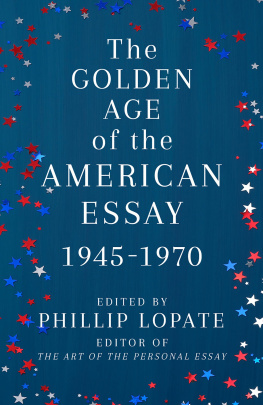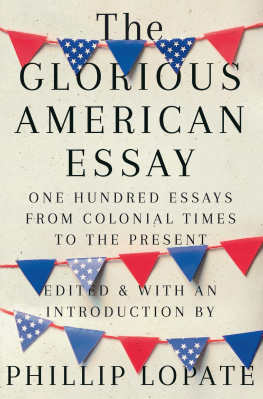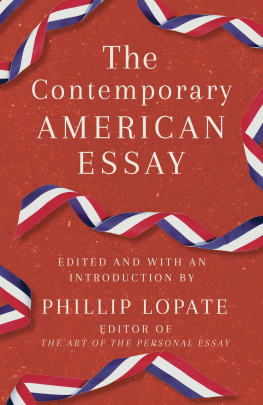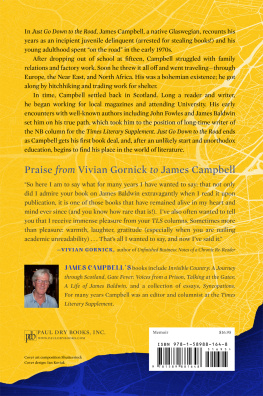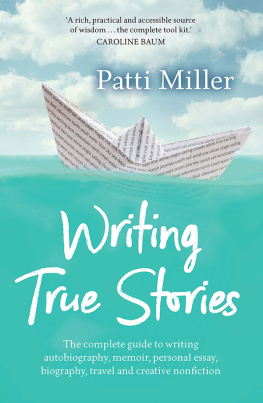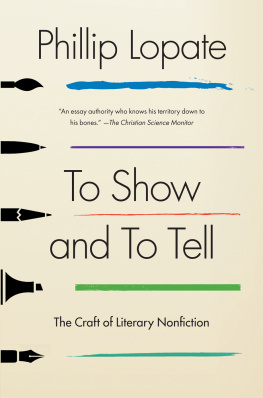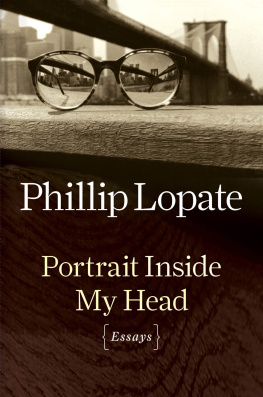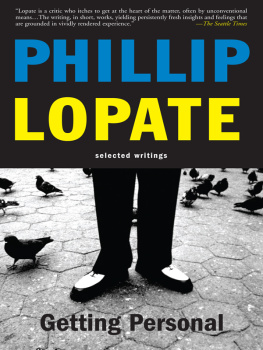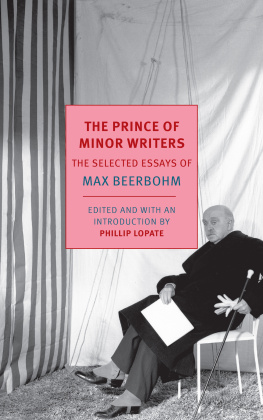
Thank you for purchasing this Free Press eBook.
Join our mailing list and get updates on new releases, deals, bonus content and other great books from Free Press and Simon & Schuster.
C LICK H ERE T O S IGN U P
or visit us online to sign up at
eBookNews.SimonandSchuster.com

Contents

I.
The Craft of Personal Narrative
II.
Studies of Practitioners
Introduction

I should explain straight-out that I consider myself to be as much a teacher as a writer. Its not simply that a good deal of my annual income derives from teaching; its also that I find it a fascinating challenge, one that nourishes my psycheand my own writing. Many of my fellow writers treat teaching as a lower calling; they only do it to pay the rent, or until such time as they can support themselves entirely from royalties and advances. For my part, I think I would continue to teach even if I were to win the lottery. I find myself needing to articulate responses on the spot to any and all questions put me by students and their manuscripts, regardless of how much I may feel myself to be bluffing. I am also intrigued whenever I encounter resistance to my advice. Since I tend to doubt myself and my wisdom, I even feel some sympathy with those who want to question my prescriptions, though that does not stop me in the least from continuing to offer them.
Ever since my anthology The Art of the Personal Essay appeared, I have been looked to, rightly or wrongly, as a spokesperson for the essay, and for creative nonfiction or literary nonfiction (call it what you will) in general. I have been asked to speak at campuses and conferences across the country, and invariably I have been confronted with certain questionsformal, strategic, and ethicalthat seem to issue from an insistent anxiety or perplexity. Some of these questions have to do with the borderline between fiction and nonfiction or with the freedom to invent, appropriate, or embroiderwhat Ive come to regard as law and order issues. When this debate cropped up, my first impulse was to throw up my hands and say the whole controversy has been blown out of proportion and bores me, because it does not speak to where I live as a nonfiction writer (the urge to write the next sentence with as much style and thoughtfulness as I can muster). But I have come to see this neutral response on my part as hypocritical, because I do have opinions on such matters. So I have tried in these pages to explain them, though I hope it will be clear that I am talking about what works for me, not necessarily for everyone.
There are also vexing questions about the ethics of writing about others, particularly family members, intimates, and colleagues. There are questions of technique, such as how do you turn yourself into a character, how do you end an essay, and finally, how do you develop the capacity to think entertainingly and unconventionally on the page? The books title, To Show and to Tell , directly speaks to this last problem by challenging the clich of writing workshops, Show, dont tell. I am convinced that both are necessary in literary nonfiction.
What brought me to this conviction was reading older writers: the great personal essayists, memoirists, critics, biographers, and historians of the past. In a sense I am defending here the historical prerogatives of the literary nonfiction form, to charm and entice by way of a voice that can speak in more than one register, that can tell an anecdote, be self-mocking and serious by turns, and analyze a conundrum. My deepest inclination as a writer is historical: to link up what is written today with the rich literary lode of the past. My profoundest belief as a teacher is that many solutions for would-be literary nonfiction writers can be found in the library. To that end, I have included here a long list of exemplary books old and new. I have also included a series of literary case studiesCharles Lamb, William Hazlitt, Ralph Waldo Emerson, James Baldwin, and Edward Hoaglandto explore how nonfiction theory works in practice.
Some of these pieces were commissioned or requested; they may have gotten their start as conference talks, contributions to anthologies, even columns for Creative Nonfiction magazine. But they all speak to the same urgent question, of how to write intelligent, satisfying, engaging literary nonfiction.
So who is this book for? On the most basic level, it is for myself, to enable me to work through my thoughts on these questionsand for other nonfiction writers with similar concerns. It is certainly for other teachers of nonfiction and, I would hope, for graduate MFA nonfiction students. It is for what Virginia Woolf called the common reader, not a critic or scholar but someone who reads for his own pleasure rather than to impart knowledge or correct the opinions of others. It is meant as well for undergraduate teachers of composition and creative writingand their students. But it doesnt end there, because the roots of such pedagogical practice extend down to high school, middle school, and even elementary school, where teachers are increasingly being asked to inculcate in their charges the ability to write effective nonfiction.
I feel for these teachers. Third graders are now being asked to write their memoirs: an invitation which sounds risible, were it not also sensible. It is never too early to know thyself, to begin to interrogate ones experience. The summa of such efforts is the dreaded college application, or Common App essay. On the one hand, the Common App essay encourages high school seniors to write with a strong, seductively individual voice, in the classic tradition of the personal essay. On the other hand, the common core curriculum now being implemented for middle and high school students stresses the need to construct an argumentative essay, which stakes a claim and supports it. How, then, to balance the adventurousness of an exploratory essay that tracks the authors consciousness and may lead to surprising, original insights, with the need to support a logical argument? Such problems are not irreconcilable, as I have tried to show in The Essay: Exploration or Argument?
Believe me, I am thrilled that educators from elementary through secondary schools are starting to place much more emphasis on nonfiction writing. I am less thrilled if it means sacrificing that part of the curriculum formerly devoted to writing stories and poems. Both genres, aside from their innate cultural worth, can be crucial in helping to refine a flexible nonfiction style: fiction, by sharpening the sense of narrative line and character; poetry, by promoting concise language, careful diction, and imaginative use of images and metaphors.
I also have mixed feelings about a certain rigid, mechanistic approach to the evaluation of essays. There are automated systems currently being developed to score middle school and high school test essays, systems which reward long sentences, syntactical complexity, connectors such as however or moreoverall good things, no doubt, but these robot scorers arent sensitive enough to gauge original thought, emotional expressiveness, or honesty. We ought to be training young people not just to assert a claim or use bigger words but to think criticallyto think against themselveswhich may necessitate the abandoning of an original argument or thread for a fruitful digression or self-contradictory ambivalence. In short, the pragmatic justification for learning to write nonfiction effectively should be joined to a renewed respect for the literary traditions that open up extraordinarily ample vistas of interiority, complexity, and stylistic experimentation. My hope is that this book will help to shift the conversation in that direction.
Next page

